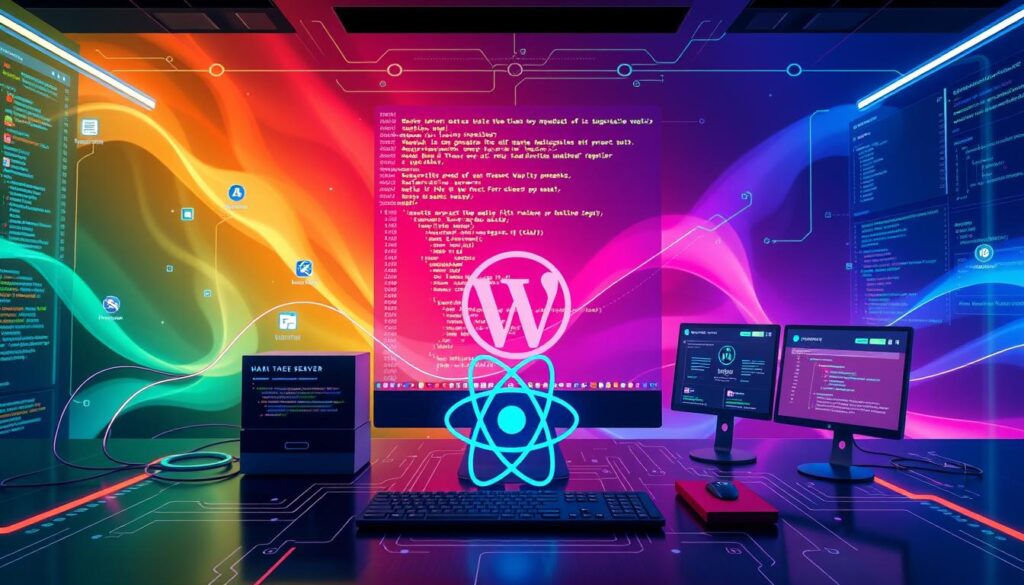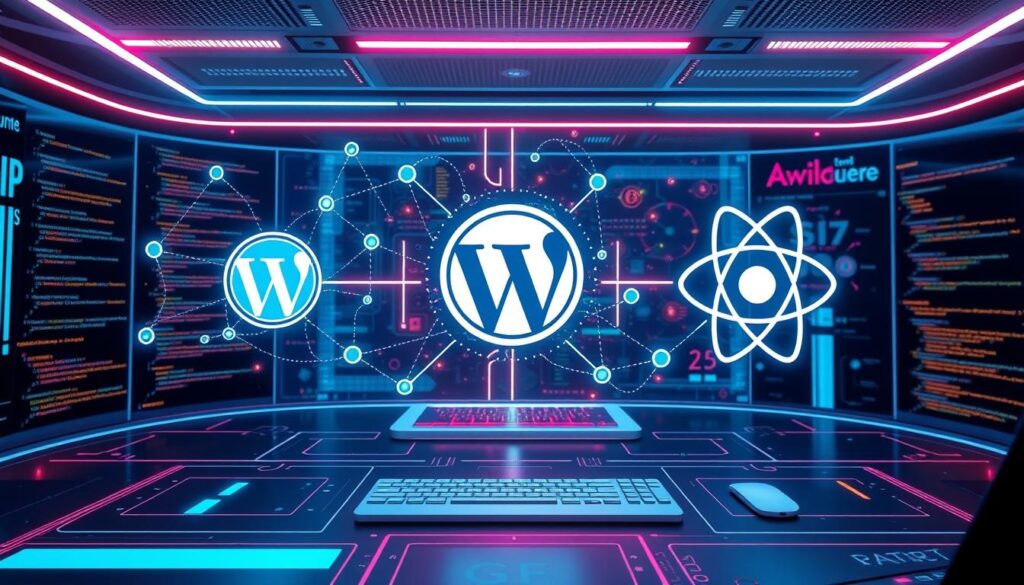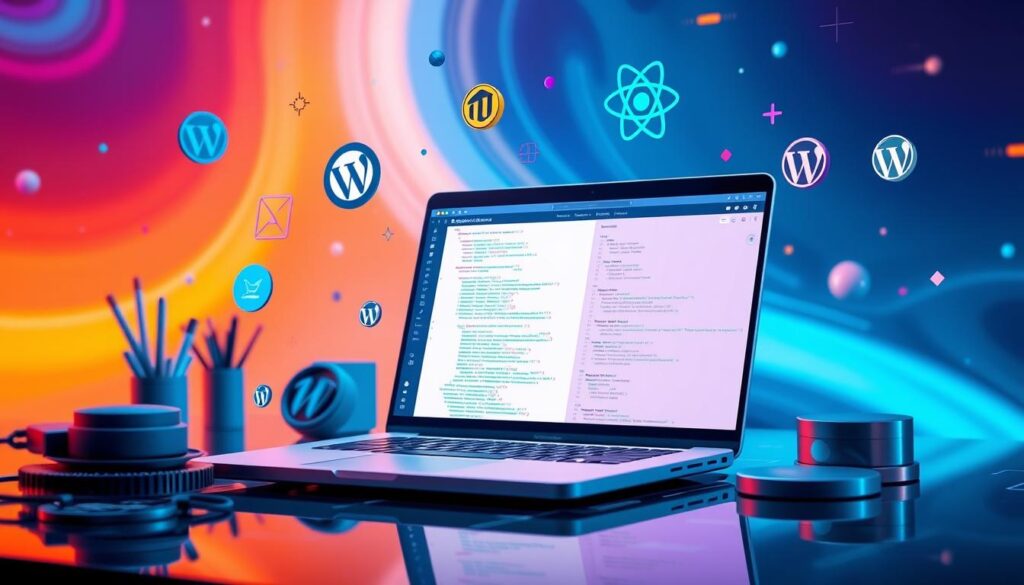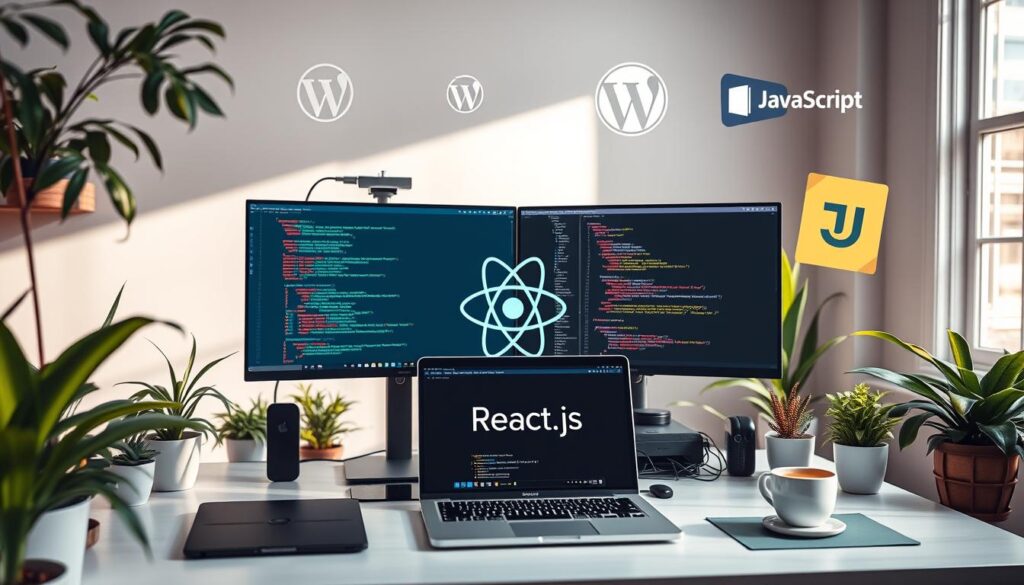A headless WordPress website uses WordPress as a backend and React.js for the frontend. This setup makes websites more flexible and customizable. It’s perfect for today’s web development needs.
Developers can make fast, scalable websites with a headless WordPress setup. We’ll show you how to create one with React.js. You’ll learn about the basics, setting up WordPress, and using the WordPress REST API.

This method gives developers more control over their websites. It’s great for creating customized websites that meet today’s standards. With a headless WordPress site, you can make websites that are fast, scalable, and user-friendly.
Introduction to Headless WordPress
We’ll explore the world of headless WordPress in this article. We’ll look at its benefits and challenges. You’ll learn how to set up a headless WordPress website with React.js, from the backend to connecting with the WordPress REST API.
Key Takeaways
- Understanding the benefits of a headless WordPress website
- Setting up the WordPress backend for a headless cms
- Creating a React.js development environment
- Connecting React.js to the WordPress REST API
- Building a fast and scalable headless website
- Leveraging the power of a headless cms for modern web development
Understanding Headless WordPress Architecture
Headless WordPress uses WordPress as a backend system. The frontend is built with a separate framework, like React.js. This setup offers flexibility, better performance, and security. The WordPress REST API is key, letting the frontend and backend talk to each other.
Headless WordPress, or headless CMS WordPress, is becoming more popular. It’s great for building modern web apps. Developers use WordPress for content management and their favorite frontend framework for the UI.

Using a headless WordPress setup means you can manage content with the WordPress REST API. This API makes it easy to work with WordPress data. It helps create a smooth experience between the frontend and backend.
What is Headless WordPress?
Headless WordPress separates the content management system from the frontend. This lets developers use WordPress as a backend CMS. They can then use a separate framework, like React.js, for the frontend.
Benefits of Decoupled Architecture
The decoupled architecture of headless WordPress has many benefits. It improves performance, security, and flexibility. By separating the backend from the frontend, apps can be faster and more scalable.
WordPress REST API Basics
The WordPress REST API makes it easy to work with WordPress data. It lets developers fetch and manage content. They can also create custom apps and integrations, making the frontend and backend work together seamlessly.
Essential Prerequisites for Development
To build a headless WordPress website, you need to know a few key things. You should understand WordPress, React.js, and the WordPress REST API. Also, having a code editor, a package manager like npm or yarn, and Git for version control is important.
When you’re working on a headless WordPress site, setting up your environment is key. You’ll need a code editor, a package manager, and Git. Knowing WordPress, React.js, and the WordPress REST API is also vital for a smooth process.
Before you start, make sure you have the right tools and knowledge. This includes a code editor, a package manager, and Git. With these in place, you’re ready to start your headless WordPress project.

Knowing what you need to start is the first step to a successful headless WordPress site. It’s about having the right tools, knowledge, and process. This ensures a great user experience.
Setting Up Your WordPress Backend
To make a headless WordPress website work well, setting up the backend is key. You need to install plugins, set up REST API, CORS, and authentication. A good wordpress headless theme is vital for a smooth setup.
For plugins, WP REST API and WP GraphQL are top picks. They help a lot with a headless WordPress setup. Setting up REST API is also important. It lets you customize API endpoints and how users log in. A theme made for headless architecture is best.

Installing Required Plugins
Plugins like WP OAuth and JWT Authentication help with CORS and authentication. They make sure only the right people can access the API. Following best practices helps make a strong and flexible backend. This backend can work with many frontend apps.
Configuring REST API Settings
Setting up REST API means tweaking API endpoints, login methods, and data formats. This is key for the backend and frontend to talk smoothly. A good headless setup considers the frontend’s needs for a great user experience.
Creating Your React.js Development Environment
To start building a headless website with React.js and a headless cms, you need a development setup. First, create a new React.js project with tools like create-react-app. This tool gives you a ready-to-use environment, letting you focus on your website.
After setting up your project, install the needed dependencies. You’ll need axios and react-router-dom. These tools help you connect to your headless cms and manage your website’s routes.

With dependencies installed, it’s time to configure your environment. You might set up a code editor, use debugging tools, and plan a workflow for building and testing. These steps help you create a React.js environment perfect for a headless website with a headless cms.
Connecting React.js to WordPress REST API
To connect React.js with the WordPress REST API, you need to know how to authenticate and fetch data. The WordPress REST API is great for building headless CMS WordPress apps. It makes it easy to interact with WordPress data.
Authenticating with the WordPress REST API is key. You can use OAuth or JWT for secure authentication. This lets your React.js app safely get and update data from WordPress.
Getting data from WordPress is also important. The WordPress REST API has many endpoints for data like posts and pages. Developers can use these to power their React.js apps, making them smooth and engaging.
API Authentication Methods
API authentication methods like OAuth and JWT are vital. They secure API requests and ensure only authorized apps can access WordPress data. This protects your WordPress REST API from unauthorized access.
Fetching WordPress Data
Getting WordPress data is easy with the WordPress REST API. Developers can use the API’s endpoints to get the data they need. This includes posts, pages, and custom post types for their React.js apps.
Handling API Responses
Dealing with API responses is critical for a headless CMS WordPress app. Libraries like axios help developers handle responses well. They can parse data and manage errors efficiently.
Building the Frontend Component Structure
Creating a headless WordPress website needs a solid frontend component structure for a smooth user experience. This means designing React.js components that work well with the WordPress backend. With frontend WordPress’s flexibility, developers can make custom components for things like posts, pages, or special post types.
First, plan the component hierarchy. Identify the components needed, like headers, footers, and content sections. A well-organized hierarchy ensures a consistent and easy-to-use interface. The headless WordPress method lets developers tailor the structure for a better user experience.
After setting up the hierarchy, developers can style the components with CSS preprocessors like Sass or Less. This makes writing and updating CSS code easier. By using headless WordPress and frontend WordPress together, developers can build a strong, scalable website for today’s users.
Implementing Dynamic Routing in React
Building a headless website with a headless cms needs dynamic routing for a smooth user experience. In React.js, this means setting up route configurations for different URLs. It also means handling page changes well.
Developers can use libraries like react-router-dom for this. It makes setting up routes and handling URL changes easy. By linking it with the WordPress REST API, developers can build a strong routing system. This system fetches data from the headless cms and shows it on the frontend.
Creating Route Configurations
Setting up route configurations means defining paths and components for each URL. This is done using react-router-dom. It offers a simple API for setting up routes.
Handling WordPress URLs
Handling WordPress URLs means linking the WordPress REST API with the React.js app. This involves getting data from the API and using it to show the right components.
Managing Page Transitions
Managing page transitions is key for a good user experience. Libraries like react-transition-group help create animations and transitions. This makes the app feel more alive and engaging.
Managing WordPress Content in React
Building a headless WordPress website with React.js means managing content well. This includes showing posts, pages, and custom types. Developers use the WordPress REST API to get and show content in React. This makes the site work well without mixing frontend and backend.
Managing content starts with setting up the WordPress REST API. This lets developers use React.js to show content. For example, the
Posts and Pages Integration
Integrating posts and pages in React.js uses the WordPress REST API. Libraries like react-fetch or axios help make API requests. This way, developers can make fast, scalable sites that are easy to customize.
Custom Post Types Display
Showing custom post types in React.js needs special components. These components handle each post type’s data. Using a headless WordPress approach, developers can show these types in React. This makes the site feel smooth and connected.
State Management for Headless WordPress
Building a headless WordPress site with React.js means managing the app’s state well. This includes fetching and caching data and improving performance. Libraries like Redux or MobX help manage the app’s state efficiently.
React-query is great for handling data fetching and caching. It makes data management simple and boosts performance. Code splitting and lazy loading also help make the app faster.
Good state management is key for a smooth user experience. With the right tools, developers can build fast, efficient apps. These apps meet user needs and scale well.
Optimizing Performance and Loading Times
Building a headless website is all about speed. A slow site can make users leave quickly and hurt your search rankings. To fix this, developers use smart tricks.
One way is caching, which keeps often-used data ready for quick access. This cuts down server requests, making pages load faster. Code splitting is another tactic, breaking down big code into smaller bits for quicker loading.
Don’t forget about images. Big, detailed images can slow down your site. Tools like image-webpack-loader help make images smaller and faster to load. These steps help make your site fast and user-friendly, key for a headless cms.
Caching Strategies
Using caching is easy with tools like react-cache. It keeps data in memory, cutting down on server requests. This makes your site load faster.
Code Splitting Techniques
Code splitting breaks down big code into smaller pieces. This makes loading resources more efficient. Libraries like react-loadable help load components on demand, reducing initial load times.
Implementing SEO Best Practices
Creating a headless WordPress website means you need to focus on SEO. This setup offers flexibility but requires careful SEO planning. By optimizing your site, you can make it faster, better for users, and more visible online.
In a headless WordPress setup, the frontend and backend are separate. This means you can’t use old SEO tricks. Instead, focus on keyword research, meta tags, and image optimization. This way, your site will be fast and friendly to both users and search engines.
Using a headless WordPress setup lets you pick from many frontend options. This makes your site fast and user-friendly. To make the most of it, use SEO best practices like optimizing images and creating great content. This will help your site get more visitors and boost your online presence.
By following these tips, you can make a headless WordPress site that’s great for users and search engines. Remember to work on keyword research, meta tags, and image optimization. With a well-optimized site, you can attract more visitors and succeed online.
Security Considerations for Headless WordPress
Building a headless WordPress website with the WordPress REST API means security is key. There are risks like SQL injection and cross-site scripting (XSS) that need to be stopped. It’s important to protect user data and keep unauthorized access out.
Setting up a headless CMS WordPress needs careful thought on how to keep content safe. Libraries like OAuth and JWT help with this. Also, using encryption and access control can keep sensitive info safe.
By taking these steps, developers can make their headless WordPress site safe. Using a headless CMS WordPress with the WordPress REST API is a smart way to build fast, secure web apps. Prioritizing security and following best practices helps create a reliable site for users.
API Security Measures
API security steps like rate limiting and IP blocking can stop brute-force attacks. These can be set up with plugins and libraries made for the WordPress REST API.
Authentication Best Practices
Using secure protocols for logging in and out is a good practice. It makes sure only the right people can get to the site’s content.
Data Protection Strategies
Strategies like encryption and access control keep data safe. These steps help protect against threats and keep the site secure.
Deploying Your Headless WordPress Site
Deploying a headless WordPress site is key to making it public. You need to pick a hosting option, set up a deployment workflow, and configure the environment. A headless site is great for developers because it’s flexible and scalable.
A headless cms like WordPress makes managing content easier. A headless website, on the other hand, offers a quicker and safer user experience. When deploying, consider hosting on AWS or Google Cloud for reliable and scalable solutions.
Hosting Options
Choosing the right hosting is vital for a headless WordPress site. Options like AWS, Google Cloud, and Microsoft Azure are popular. They provide services and tools for deployment and management.
Deployment Workflows
Setting up a deployment workflow is key for a smooth process. Tools like Git and Jenkins help automate deployment. This ensures changes are quickly and reliably updated on the live site.
Environment Configuration
Configuring the environment is the last step in deploying a headless WordPress site. You’ll need to set up Docker and Kubernetes to manage containers. This makes sure the site is secure, scalable, and fast.
Monitoring and Maintaining Your Site
After setting up your headless WordPress site, it’s key to keep an eye on it. Use tools like Google Analytics and New Relic to track how well it’s doing. Also, fix problems with debugging and logging tools, and update it often with Git and WordPress updates.
Keeping your site updated is vital. It stops security risks and makes sure it works well with new plugins and themes. Regular checks help avoid problems and keep your site running smoothly. This includes looking at server logs, updating software, and making backups.
Choosing the right tools is important for site upkeep. For instance, Jetpack can watch your site’s health and safety. New Relic helps track performance and find ways to get better. These tools help your site run at its best.
By following these tips, your headless WordPress site will be safe, fast, and reliable. Regular checks and upkeep are key to a successful site. By focusing on these, your site will stay in top shape for your visitors.
Troubleshooting Common Issues
Working with a headless wp setup can lead to common problems. These include API connection issues, performance bottlenecks, and content sync problems. It’s important to solve these to ensure a smooth user experience for your frontend wordpress app.
Start by using tools like Postman and cURL to test API connections. They help you simulate requests and check responses. For performance issues, Chrome DevTools and WebPageTest offer insights into where to optimize.
API Connection Problems
API connection issues can be a big headache. But, the right tools can make debugging easier. Analyzing API headers can reveal problems like authentication errors or rate limits.
Performance Bottlenecks
Performance issues can hurt your app’s user experience. To fix this, monitor page load times and resource use. Optimizing code and using caching can boost your headless wp setup’s performance.
Content Sync Issues
Content sync problems happen when data between your backend and frontend gets out of sync. To solve this, use a strong content sync strategy. Tools like WordPress debug mode and logging help identify and fix these issues.
Conclusion
Building a headless WordPress website with React.js is a smart move for web development today. It lets developers make fast, secure, and customizable websites. We’ve shown you how to set up the WordPress backend and link it with React.js.
This headless CMS method lets developers use WordPress for content management. At the same time, they get the perks of a modern, JavaScript-based frontend. By using the tips from this article, you can make the most of a headless WordPress setup. This will help you create websites that impress users.
Starting your headless WordPress project? Be ready to adapt and keep improving. With the right attitude and knowledge, you’ll make a website that’s both seamless and amazing.
FAQs
What is Headless WordPress?
Headless WordPress is when WordPress is used as a backend system. The frontend is built with a different framework, like React.js. This setup makes the site more flexible, fast, and secure.
What are the benefits of a Headless WordPress architecture?
A Headless WordPress setup offers many advantages. It’s more flexible, runs faster, and is more secure. It also lets developers create unique user experiences. This is because the frontend and backend are separate.
What is the WordPress REST API, and how does it work in a Headless WordPress setup?
The WordPress REST API lets developers interact with the WordPress backend. In a Headless WordPress setup, the React.js frontend uses this API to talk to the WordPress backend. This makes the two work together smoothly.
What are the essential prerequisites for building a Headless WordPress website with React.js?
To build a Headless WordPress site with React.js, you need to know WordPress, React.js, and the REST API. You also need a code editor, a package manager like npm or yarn, and Git for version control.
How do you set up the WordPress backend for a Headless WordPress website?
Setting up the WordPress backend involves installing plugins and configuring the REST API. You also need to set up CORS and authentication. Plugins like WP REST API and WP GraphQL can help.
How do you create the React.js development environment for a Headless WordPress website?
To set up a React.js environment, start a new React.js project with create-react-app. Then, install dependencies and configure your environment. You’ll need libraries like axios and react-router-dom.
How do you connect React.js to the WordPress REST API?
To connect React.js to the WordPress REST API, authenticate with the API using OAuth or JWT. Then, fetch data from WordPress and handle API responses with libraries like axios.
How do you implement dynamic routing in a Headless WordPress website built with React.js?
For dynamic routing, create route configurations with libraries like react-router-dom. Use the WordPress REST API to handle WordPress URLs. Manage page transitions with libraries like react-transition-group.
How do you manage WordPress content in a React.js-based Headless WordPress website?
To manage WordPress content, integrate posts and pages, display custom post types, and handle media. Use the WordPress REST API and libraries like react-media.
How do you optimize performance and loading times for a Headless WordPress website?
To improve performance, implement caching, use code splitting, and optimize images. Use libraries like react-cache, react-loadable, and image-webpack-loader.
What are the security considerations for a Headless WordPress website?
For security, implement API security measures and follow authentication best practices. Protect data with encryption and access control. Use libraries like OAuth and JWT.
How do you deploy a Headless WordPress website?
Deploying a Headless WordPress site involves choosing a hosting option and setting up a deployment workflow. Use tools like AWS, Google Cloud, Git, Jenkins, Docker, and Kubernetes.
How do you monitor and maintain a Headless WordPress website?
Monitor and maintain the site by tracking performance with tools like Google Analytics and New Relic. Fix issues with debugging and logging tools. Update the site regularly with Git and WordPress updates.
How do you troubleshoot common issues in a Headless WordPress website?
Troubleshoot issues by identifying and fixing API connection problems, performance bottlenecks, and content sync issues. Use tools like Postman, Chrome DevTools, WebPageTest, and WordPress debug mode.

